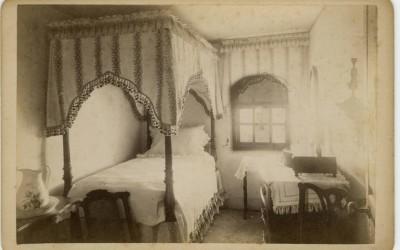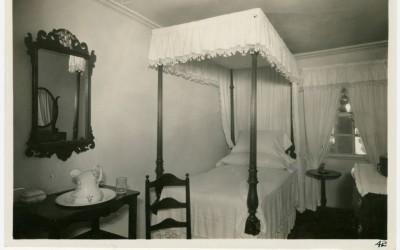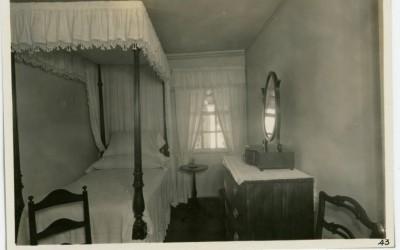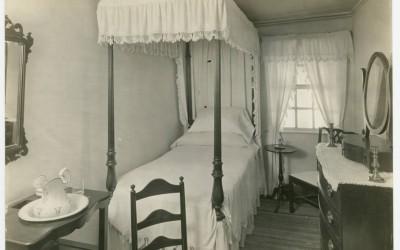The probate inventory taken after George Washington’s death indicated it was furnished comfortably but not elaborately, with a low-post bedstead and bedding, a curtain, inexpensive Windsor chairs for seating, and a wash stand, dressing table, and dressing glass.
Curators chose a combination of original, period, and reproduction furnishings to represent the room c. 1799.
Original Washington Wash Stand
The wash stand, or more specifically, shaving stand, is the Washington-owned original, purchased by George Washington in August 1774 from the auction of furnishings from Belvoir, the Fairfax family home. The compact piece features a mirror that slides out from the case and can be adjusted to suit the user’s height, as well as a fitted top for a salt-glazed stoneware wash basin, soap basins, a cupboard for storing shaving implements or other tools or accessories, and a shelf for a guglet or water bottle.
George William Fairfax had purchased the shaving stand from London cabinetmaker William Gomm in 1763 and used it in his dressing room at Belvoir for over a decade. After purchasing it in 1774, Washington likely used it himself for many years, until he acquired the larger, marble-topped French dressing table in 1790 (W-202).
After that, it became one of several wash stands that could be used in guest chambers. With convenient carrying handles on the sides, the stand could easily have been moved from room to room as needed to accommodate guests.
Low-Post, Virginia-Made Bed
The low-post bedstead with turned posts is an extraordinary example of a Virginia-made bedstead from the mid-eighteenth century. It represents the type of less expensive bedsteads acquired by the Washingtons in the 1750s and 1760s (including several brought by Martha to Mount Vernon from the Custis homes of her first marriage) that continued in use in the Mansion throughout their lifetimes.
The turnings on this bedstead and Tidewater Virginia staircases were made by specialty turners whose craftsmanship can be seen in architecture and in furniture. The turnings of this particular bed relate to similar examples on stairs and tables found near Norfolk, Virginia, the port city nearest many of the Custis landholdings.



















